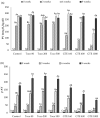Green Tea Extract Enhances the Oxidative Stability of DHA-Rich Oil
- PMID: 34205438
- PMCID: PMC8235633
- DOI: 10.3390/antiox10060982
Green Tea Extract Enhances the Oxidative Stability of DHA-Rich Oil
Abstract
Docosahexaenoic acid (DHA) is one of the most important omega-3 polyunsaturated fatty acids, with proven health-promoting properties. However, oils with a very high content in DHA (DHAO) are extremely susceptible to oxidation, which affects shelf stability and limits incorporation in food products. Green tea extracts (GTE) are potential candidates for the protection of these oils, but their use in such oils has not been previously reported. This study investigated the effect of GTE (160 ppm, 400 ppm, 1000 ppm) and α-tocopherol (80 ppm, 200 ppm, 500 ppm) on the oxidative stability of a DHAO over a 9-week storage at 30 °C. The oxidative status was monitored during storage by the measurement of peroxide value (PV) and p-anisidine value (p-AV). Changes in eicosapentaenoic acid (EPA) and DHA content, as well as in catechins and tocopherol contents, were also evaluated. The addition of GTE enhanced the oxidative stability of DHAO by reducing the formation of peroxides and secondary oxidation products, whereas α-tocopherol had no significant effect on the PV of oil during storage but led to a significantly higher p-AV. The EPA and DHA content of DHAO was stable in GTE-supplemented samples whereas a decrease was observed in the control and α-tocopherol-supplemented samples. GTE also delayed the degradation of tocopherols initially present in the oil, while catechins resulting from the addition of GTE decreased progressively during the storage period.
Keywords: DHA-rich oil; alpha-tocopherol; catechins; green tea extract (GTE); natural antioxidants; oxidation.
Conflict of interest statement
The authors declare no conflict of interest.
Figures



References
-
- Vázquez L., Corzo-Martínez M., Arranz-Martínez P., Barroso E., Reglero G., Torres C. Bioactive Lipids. In: Mérillon J.-M., Ramawat K.G., editors. Bioactive Molecules in Food. Springer International Publishing; Cham, Switzerland: 2019. pp. 467–527. - DOI
-
- (AFSSA), Agence Française de Sécurité des Produits Alimentaires . Opinion of the French Food Safety Agency on the Update of French Population Reference Intakes (ANCs) for Fatty Acids. AFSSA; Maisons-Alfort, France: 2010. Request no. 2006-SA-0359.
-
- Ismail A., Bannenberg G., Rice H.B., Schutt E., MacKay D. Oxidation in EPA- and DHA-rich oils: An overview. Lipid Technol. 2016;28:55–59. doi: 10.1002/lite.201600013. - DOI
Grants and funding
LinkOut - more resources
Full Text Sources
Research Materials

